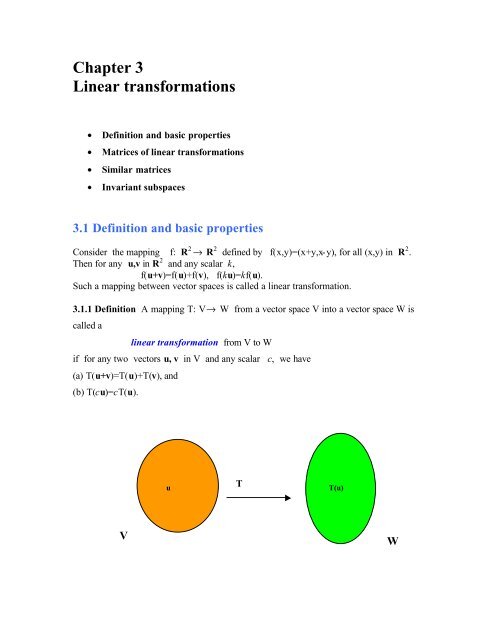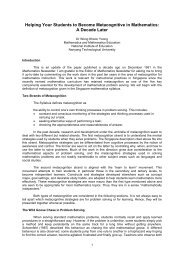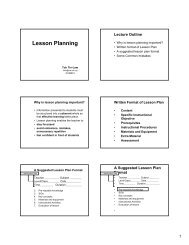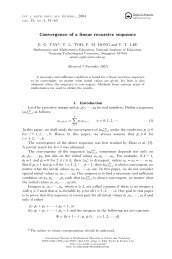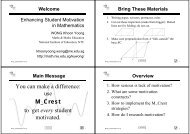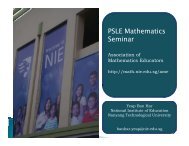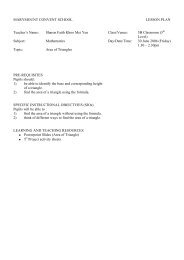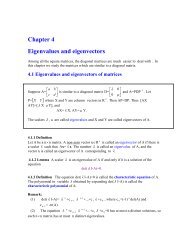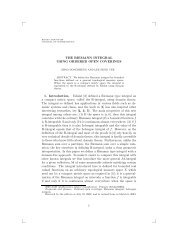Chapter 3 Linear transformations
Chapter 3 Linear transformations
Chapter 3 Linear transformations
Create successful ePaper yourself
Turn your PDF publications into a flip-book with our unique Google optimized e-Paper software.
The Landmark Tshipi Acquisition & Company OverviewMarch 20101
A linear transformation T:V → V from V into itself is called a linear operator on V .We use L(V) to denote the set of all linear operators on V.If a linear transformation T:V → W is a bijection( i.e. injective and surjective), it iscalled alinear isomorphism.If there exists an isomorphism between V and W we say that V and W areisomorphic.3.1.2 Example(1) The mapping T: R 2 → R 3 defined by T(x,y)=(x-y,2x,2x+y) is a lineartransformation. Note that if we write each vector as a one column matrix, then for eachu∈R, T(u)= Au, where⎡1−1⎤A=⎢ ⎥⎡x ⎤⎢2 0⎥and u= ⎢ ⎥ .⎢⎣2 1 ⎥⎣y⎦⎦(2) Let C[0,1] be the vector space of all continuous real valuedfunctions defined on [0,1]. Define the map T:C[0,1]→ R byT(f)= ∫ 1 0f ( x)dx .Then T is a linear transformation from C[0,1] to the vector space R of real numbers.(3) For each f(x)=a nx n +a −1T(f(x))=f'(x),nx n −1the derivative of f(x).+… +a 1x+ a 0in P n, letThen T: P n→ P n −1and is a linear transformation.(4) Let V be a vector space with dimension n, and let B={ b 1,b 2,. . . ,b n} be a basis ofV. Define a mapping T: V→ R n byT(u)=(u 1,u 2,. . .,u n),which is the coordinate vector of u with respect to the basis B. Then T is a lineartransformation, and it is actually an isomorphism.
Thus P 2 is isomorphic to R 3 , and P n is isomorphic to R n+1 .Usually we use [.] Bto denote this linear isomorphism. From this it follows that every n-dimensional space is isomorphic to R n . Hence very two n-dimensional vector spacesare isomorphic.(5) The mapping T:R 2 → R 2 defined by T(u)=u+(1,2) is not linear.Exercise Let M 22 be the vector space of all two by two matrices. To which R n is M 22isomorphic ?3.1.3 TheoremLet T:V → W be a linear transformation. Then(1) T(0)=0;(2) T(a 1u 1+a 2u 2+. . . +a m u m )=a 1T(u 1)+a 2T(u 2)+. . . +a m T(u m ), for any vectors u iand scalars a i(i=1,. . . ,n);(3) T(-u)=-T(u) for any vector u.3.1.4 DefinitionLet T:V → W be a linear transformation.(1) The kernel of T, denoted by ker(T), is the setker(T)={u∈V: T(u)=0 }.(2) The range of T, denoted by R(T), is the setR(T)={ T(u): u∈V}.The rank of T, denoted by rank(T) , is defined to be the dimension of R(T)The nullity of T denoted by nullity(T), is defined to be the dimension of ker(T).
Ker(T)0VWR(T)VW3.1.5 Theorem Let T:V → W be a linear transformation. Then R(T) is a subspace of W,and ker(T) is a subspace of V.3.1.6 Example(1) Let T A: R n → R m be the linear transformation defined by T A(u)=Au, whereA is an m× n matrix. Then ker(T A) ={ u: T A(u)=0} ={u: Au=0}, which is actually thenullspace of A . Also R(T A)={ Au: u is an arbitrary vector in R n }, so it is the columnspace of A.(2 ) Let V be a vector space. Define F: V → V by F(u)=3u, for all u in V. ThenF is a linear transformation. What is ker(F) and R(F) ?(3) Let T: P n→ P n −1be the derivative function. Then
ker(T) ={p(x): p’(x)=0}={ all constant polynomials}. So nullity(T)=1.Also rang(T)= P n −1, so rank(T)=n.Note that rank(T)+nullity(T)=n+1=dim(P n).3.1.7 Theorem(Dimension Theorem for linear <strong>transformations</strong>})Let T:V → W be a linear transformation from an n-dimensional space V to an m-dimensional space W, thenrank(T)+nullity(T)=n.3.1.8 Theorem Let T: V→ W be a linear transformation. ThenT is injective if and only if ker(T)={0}.Exercise 3.11. Determine which of the following mappings are linear <strong>transformations</strong>.(1) T: P n→ R n , where T sends a polynomial p= a nx n +a −1to the vector T(p)=( a 0, a 1+ a 0,. . . , a n+a n −1+… +a 1+ a 0).nx −1n +… +a 1x+ a 0(2) T: C[0,1] → R, where for each f(x) in C[0,1],T(f)= ∫ 1 0f ( x)h(x)dx ,where h(x) is a fixed continuous function.
(3) T: R 3 → R 3 , where T(u)=(-x, 2, 3) for each u=(x,y,z) in R 3 .2. Let T: R 3 → R 3 be defined by T(x,y,z)=(x,0,z). Find rank(T) and nullity(T).3. Let T and F be two linear <strong>transformations</strong> from V to W and k and l be scalars. Showthat kT+lF is also a linear transformation, where (kT+lF)(u)=kT(u)+lF(u) for every u inV. Show that all the linear <strong>transformations</strong> from V to Wform a vector space with respect to the addition and scalar multiplication of linear<strong>transformations</strong>.4.Let M n× nbe the vector space of all n × n real matrices. Let A be a fixed n × nmatrix. Defines: M n× n→ M n× nby s (X)=AX-XA for each X in M n n.(1) Show that s is a linear transformation .(2) Prove for any X,Y in M n× n, s (XY)= s (X)Y+Xs (Y).5*. For any a, b in L(V), define [ a, b ]=ab - b a . Show that for any a , b,g in L(V),the following equation holds[[a , b ],g ]+[[ b ,g ],a ]+[[g ,a ], b ]=0,where ab is the composition of a and b .6. Let F: P 2 → P 2 be defined by F(ax 2 +bx+c)=(a-b)x 2 +(b+c).Show that F is a linear transformation. Find nullity(F) and rank(F).3.2 Matrices of linear <strong>transformations</strong>The linear transformation F: P 2 → P 2 given by F( ax 2 +bx+c)=(a+b)x+(b+c) is lessfamiliar than the transformation T: R 3 → R 2 defined by T(x,y,z)=(x+y, y+z).However F is uniquely determined by T. We can regard T as a concrete representationof the abstract transformation F.The matrix form of the linear transformation T(x,y,z)=(x+y,y+z) isTu=Au,where1 1 0⎡ ⎤A = ⎢ ⎥ .⎣01 1⎦
Also (1,0 )=T(1,0,0)=T(e 1 ), (1,1)=T(0,1,0)=T(e 2 ), (0,1)=T(0,0,1)=T(e 3 ) give the threecolumns of A, and { e 1 , e 2 , e 3 } is the standard basis of R 3 .3.2.1 Theorem Let T: R n → R m be a linear transformation and letB={ e 1,e 2,…,e n} be the standard basis of R n . Let A=[ T(e 1) T(e 2)…T(e n)] be them× n matrix with column vectors T(e i)(i=1,2,…,n). Then T=T A.The above matrix A determined by T is called the standard matrix of T.Exercise Let T: R 3 → R 2matrix of T.be defined by T(x,y,z)=(x, x+y,x+y+z). Find the standardNow let T: V → W be a linear transformation and B and S be a given basis of V and Wrespectively, then there exist linear isomorphisms[.] B: V→ R n and [.] S:W → R m ,here we assume V and W have dimension n and m respectively. Then the followingcomposition of three linear <strong>transformations</strong> is linear,R n −1[.] BV T W [.] SR m .By Theorem 3.2.1 there is a matrix A such that T Aequals this composition. Thismatrix A is uniquely determined by T and is called the matrix of T with respect to thebases B and S.2.2.2 Definition Let T: V → W be a linear transformation from the n-dimensional spaceV into m-dimensional space W, and let B and S be bases of V and W respectively. Theunique matrix A that makes the following diagram
commutes is called the matrix of T with respect to the given bases B and S, and isdenoted by A=[T]S, B.V T W[.] B[.] SR n T AR mIf T:V → V is a linear operator and B=B', then we write [T]Question: How to find [T] S, B?2.2.3 ExamplesB ',B=[T] BLet T: P n→ P n −1be the derivative linear transformation defined in Example 3.1.2(3),and B={1,1+x,. . . ., 1+x+…+x n } and S={1,2x,…, (n-1)x n −1bases of P nand P n −1respectively. Find the matrix [T]S, B.} . Then B and S areSolution Let F = [.] So T o ([.] B) − 1: R n → R m . Then by theorem3.2.1, the requiredmatrixA=[ F(e 1) F(e 2)… F(e n)].F(e 1)=H((1,0,…,0))= [.] So T o ([.] B) − 1 ((1,0,…,0))= [.] So T(1)= [.] S(0)=(0,0,…0).F(e 2)= [.] So T o ([.] B) − 1F(e 3)=[.] So T o ([.] B) − 1((0,1,0,…,0))= [.] So T (1+x)= [.] S(1)=(1,0,0,…,0)((0,0,1,0,…,0))= [.] So T (1+x+x 2 )=[.] S(1+2x)=(1,1,0,…,0)……F(e n)=(1,1,…,1).
Thus [T]S, B=A=[ F(e 1) F(e 2) … F(e n)].=⎡⎢⎢⎢⎢⎢⎢⎣00..010..011..0........011⎤⎥⎥⎥⎥⎥⎥⎦1.11Remark: In the above example, the matrix A can actually be obtained asA=[ [ T(1)] S[T(1+x)] S…… [T(1+x+…..x n )] S]In general , if B=( u 1, u 2,…, u n), then[T]S, T=[ [T(u 1) ] S[T(u 2) ] S… [T(u n) ] S].Exercise 2.21. Let T: R 3 → R 4 be given by T(x,y,z,w)=( x+y,y+z,z+w,w+x). Find [T]B ,B ',whereB={(1,1,1),(1,1,0),(1,0,0)} and B'={(1,0,1,0), (0,1,,0,1),(1,1,1,0),(0,0,1,1)}.2. Let T: P n→ P nbe the linear operator T(f)=f'. Find [T] S, where S={ 1, x-1,2( x −1)2!( x −,…,n!n1)}.3. Suppose T: R 3 → R 3 is a linear transformation such that[T] S=⎡⎢⎢⎢⎣15208−−−11157586⎤⎥⎥⎥⎦,where S ={ u 1, u 2, u 3} is a basis of R 3 . Find [T] B, whereB ={ 2u 1,+3u 2+ u 3, 3u 1+4 u 2+ u, u 1,+2u 2+2 u 3}.4. Let S={ g1, g2,...,gn} be a basis of a vector space V. Suppose
and { a ,...,such thatn∑a = gi, bj= bijgija iji = 1n∑i=1, j = 1,2,...,n1, a2an} is linearly independent. Let T: V → V be a linear operatorT( ai)= b i, i=1,2,…,n. Find [T] S.3.3 Similar matricesProblem: Given any linear operator T: V→ V on V and two bases B and B' of V, wehave two matrices: [T] Band [T] B '. What is the relationship between these two matrices?Definition 3.3.1 Let B and B' be two bases of a finite dimensional space V. There is aunique invertible matrix P, called the transition matrix from B' to B , satisfying theconditionfor all vector u in V.[u] B=P[u] B 'Proposition 3.3.2 Let B={u 1,u 2,. . .,u n} and B'={u 1',u 2',. . .,u n'} be two bases of V.Then the transition matrix from B' to B is given byP=[ [u 1'] B[u 2'] B. . . [u n'] B].Example 3.3.3 Consider the bases B={1 ,2x,3x 2the transition matrix from B' to B.} and B'={1,1+x,1+x+x 2 } of P 2. Find
Solution: By the above resultP=[[1] B[1+x] B[1+x+x 2 ] B].[1] B=(1,0,0),[1+x] B=(1,1/2,0),[1+x+x 2 ] B]=(1,1/2,1/3).Hence P=⎡⎢⎢⎢⎣10011/ 201⎤⎥⎥⎥⎦1/ 21/ 3.Theorem 3.3.5Let T:V → V be a linear operator on a finite dimensional vector space V, and let B and B'be bases for V.Then[T] B=P − 1where P is the transition matrix from B' to B.[T] B'P,Definition 3.3.6Two n× n matrices A and B are said to be similar to each other if there is an invertiblematrix P such thatA=P −1AP.
Remarks 3.3.7(1) If A is similar to B, thendet(A)=det(B)rank(A)=rank(B)nullity(A)=nullity(B)tr(A)=tr(B)(2) If A and A' are two matrices of a linear operator T:V → V with respect to twobases of V, then A and A' are similar.Exercise 3.31. Prove if A is similar to B then(a) det(A)=det(B);(b) rank(A)=rank(B);(c) tr(A)=tr(B).2. Prove if A is similar to B and A is invertible, then B
is invertible and A −1is similar to B − 1 .3. Let⎡⎢=⎢⎢⎣b⎤⎥⎥⎥⎦⎡⎢=⎢⎢⎣c⎤⎥⎥⎥⎦⎡⎢=⎢⎢⎣A c a b , B a b c , C b c a .acbacbacbaShow that A,B and C are similar to each other.4. Prove that the following two diagonal matrices are similar if and only if b1, b2,...,bnisa re-arrangement ofa ,...,1, a2a n,acbacb⎤⎥⎥⎥⎦a⎡⎢⎢⎢⎢⎣10a2..0ab⎤ ⎡⎥ ⎢⎥,⎢⎥ ⎢⎥ ⎢⎦ ⎣10b...0nb n2⎤⎥⎥⎥⎥⎦.3.4 Invariant subspaces ( optional )Given a linear operator T on V, we wish to find a basis B of V such that [T] Bis in simplerform, such as a diagonal matrix. This problem is closely related to invariant subspaceproblem.Definition 3.4.1 Let T:V → V be a linear operator. A subspace W of V is said to beinvariant under T ifT(W) ⊆ W. Then W is called W an invariant subspace of T.Example 3.4.2{0} and V are invariant under any T. These are called the trivial invariant subspaces .
Let T(u)=2u for each u in V. Then every subspace of V is invariant under this linearoperator.If W is a one dimensional subspace with a basis B={ u },then W is a invariant subspaceof T if and only if T(u)=cu for some scalar c.Remark 3.4.3Suppose that W is an invariant subspace of T. Chose a basisB={ a 1,a 2,…,a k, ak + 1,…, an} of V so that { a 1,a 2,…,a k} is a basis of W. Then[T] B=⎡⎢⎣A1A0 A22⎥⎦⎤,where A iare submatrices.In particular, if V= 1W ⊕ W2⊕ ... ⊕ Wk, then we can chose a basis B of V such that[T] B=⎡⎢⎢⎢⎢⎣A10..00A2...0............00..A k⎤⎥⎥⎥⎥⎦,where the sizes of A i’s are determined by the dimension of W i’s. If each of the W i’shas dimension one, then [T] Bbecomes a diagonal matrix.Exercise 4.31. Show that if A and B are invariant subspaces of T:V → V , then A+B and A ∩ B arealso invariantSpaces of T. ( A+B={ u+v: u ∈ A, v∈ B})2. Is the union of two invariant subspaces of a linear operator an invariant subspace?


